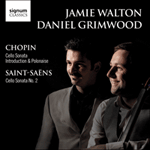
Welcome to Hyperion Records, an independent British classical label devoted to presenting high-quality recordings of music of all styles and from all periods from the twelfth century to the twenty-first.
Hyperion offers both CDs, and downloads in a number of formats. The site is also available in several languages.
Please use the dropdown buttons to set your preferred options, or use the checkbox to accept the defaults.

| Jamie Walton (cello), Daniel Grimwood (piano)» More |
‘Finally it is finished, this damned sonata! Will it please or not? That is the question.’ Thus Saint-Saëns wrote to his publisher, Jacques Durand. He was pleased about including a fugue as one of the variations of the second movement, while ‘the last movement will wake anyone who’s slept through the rest of the piece’. The Romanza is a highlight of all slow movements for cello and piano, and makes the composer’s maxim ‘Surtout, pas d’émotion’ (never too emotional, never making yourself too vulnerable) impossible to heed. ‘The Adagio will bring tears to your eyes’, he wrote to Durand. It leaves you with a feeling that you have been told something important, and is wonderful proof of Saint-Saëns’s emotional range.
from notes by Mats Lidström © 1999
«Enfin, elle est finie, cette maudite sonate! Plaira-t-elle? That is the question», écrivit-il à son éditeur Jacques Durand. Il se plut à inclure une fugue dans les variations du deuxième mouvement, cependant que «le dernier mouvement réveillera quiconque aura dormi tout le restant de l’œuvre». La Romanza, l’un des plus marquants mouvements lents pour violoncelle et piano, invalide la devise du compositeur: «Surtout, pas d’émotion» (ne jamais être trop émotif, ne jamais se rendre vulnérable). «L’Adagio vous fera monter les larmes aux yeux», écrivit-il à Durand. Il vous laisse le sentiment qu’une chose importante vous a été dite, tout en vous donnant une merveilleuse preuve de l’éventail émotionnel de Saint-Saëns.
extrait des notes rédigées par Mats Lidström © 1999
Français: Hypérion
„Endlich ist sie fertig, diese verfluchte Sonate! Wird sie gefallen oder nicht? Das ist hier die Frage“, schrieb er seinem Verleger Jacques Durand. Er freute sich, daß er als eine der Variationen des zweiten Satzes eine Fuge gewählt hatte, und meinte: „Der letzte Satz wird jeden wecken, der das übrige Stück verschlafen hat.“ Die Romanza ist ein Höhepunkt unter den langsamen Sätzen für Cello und Klavier und widerspricht der Maxime des Komponisten, nie zu emotional, zu verletztlich sein zu wollen („Surtot, pas d’émotion“). „Das Adagio wird Ihnen die Tränen in die Augen treiben“, schrieb er an Durand. Es hinterläßt das Gefühl, daß einem etwas wichtiges mitgeteilt wurde, und ist ein wunderbarer Beleg für Saint-Saëns’ emotionale Bandbreite.
aus dem Begleittext von Mats Lidström © 1999
Deutsch: Anne Steeb/Bernd Müller
 Chopin & Saint-Saëns: Cello Sonatas Chopin & Saint-Saëns: Cello SonatasTwo works from very different composers: Chopin’s works for cello were few and far between, but these two straddle his compositional life: the Introduction and Polonaise was written in 1829 when he was just 19, and the cello sonata in (1845-6) is ...» More |

